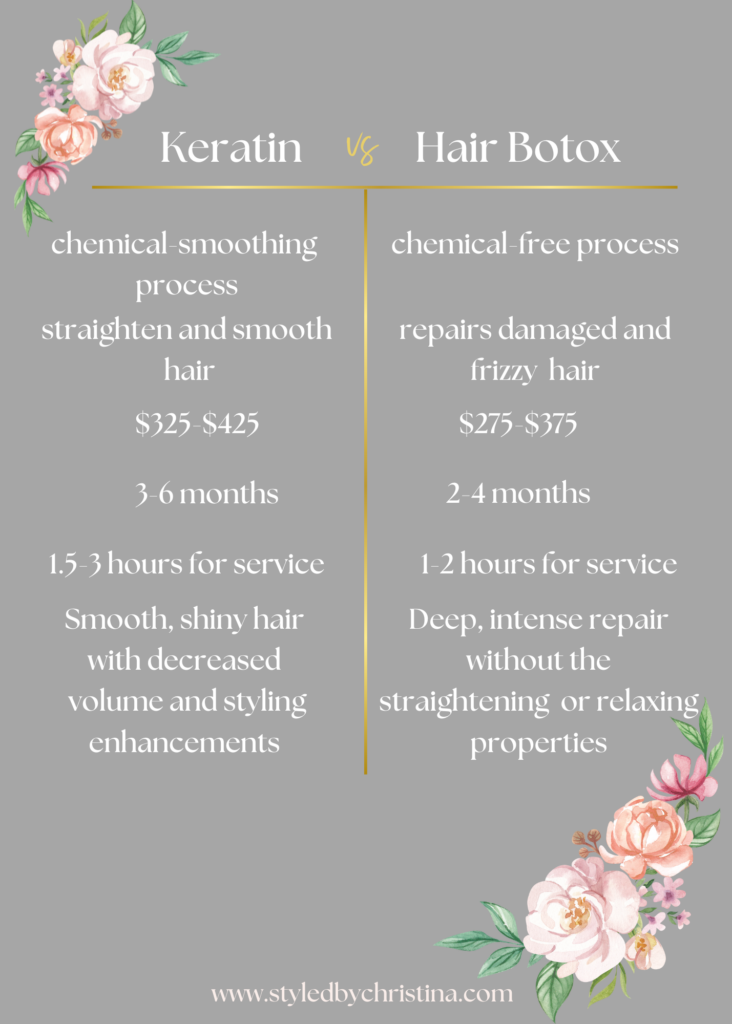
Keratin Treatments vs. Botox for Hair
Keratin Treatments
Now, let’s start with the basics of what and for whom Keratin Treatments are intended. Fun fact: Did you know the keratin protein makes up 2/3 of our hair’s structure? This is why the Keratin Treatment earned its nickname “liquid hair.” Keratin Treatments contain keratin proteins combined with other ingredients to help it penetrate deep inside the hair’s shaft. Once the solution is applied and activated, it fills the gaps in the hair, resulting in straight, smooth, strong, and shiny hair. So, if you have frizzy, unruly, or damaged tresses and struggle with your day-to-day styling process, this may be just what you need.
Keratin Treatments go by many names, with the most prominent brand known as the “Brazilian Blowout,” which is how most people reference them. Unfortunately, this is not very clear. Many companies make Keratin Treatments, such as Magic-Sleek, Coppola, Goldwell, etc., so when choosing which treatment is right for you and your hair type, a consultation with your stylist is strongly suggested because not all treatments are created equal. On average, results last anywhere from 3-6 months, depending on the post-care treatment, hair type, and lifestyle activities. There is a faster and less-committed option called the “Keratin Express,” which, in my opinion, is a great way to “dip your foot in the keratin pool.” This one is done in half the time, half the cost, and generally lasts 4-6 weeks. The Express is an excellent choice for finer hair textures because traditional keratins will likely be too heavy. Sulfate/Paraben-free products are necessary for post-care maintenance because sulfates can lift the hair’s cuticle, pulling the treatment out much sooner than intended. Saltwater, sweat, parabens, sulfates, and exfoliating agents are all best to avoid whenever possible to get the most return from your investment.
Botox for Hair
Botox for hair is a cosmetic treatment designed to restore strength and manageability, replenish what has been lost over time, and even reverse the signs of aging in hair.
This deep conditioning, restorative process is another tool in your beauty regimen box to help you achieve sleeker, shinier, healthier hair. Despite having the word ‘botox’ in its name, no botulinum toxins are involved. Hair botox is a treatment that repairs damaged and broken hair fibers, which can result from stress due to time, natural elements, chemical processes, and heat on the strands. It provides deep hydration, nutrition, and volume control by using rich ingredients like caviar oil, antioxidants, biotin, B5 and E vitamins, and collagen complex (to name a few) to moisturize and repair the hair from the inside out. Not only do these ingredients nurture your hair, but they also help fight free radicals to combat the signs of aging, brittle strands, and broken fibers. Collagen is there to further repair the hair, while the oils in the treatment help soften and seal the hair’s cuticle. Hair Botox is completely free of chemicals, while some Keratin Treatments contain formaldehyde, occasionally causing a burning sensation to the eyes, so proper ventilation is required. If your goal is to repair or reverse signs of aging in the hair while maintaining your natural texture, this treatment will do just that. Your hair will look and feel significantly healthier without the “relaxing” or “straightening” effects of a Keratin. The longevity of the treatment is 2-4 months, depending on the post-care regimen and hair texture. It is also suggested that sulfates, parabens, chlorine, and saltwater be avoided for the same reasons mentioned above.
Key Takeaways
To best sum up everything you’ve just learned about Keratins vs. Botox for Hair Treatments, the way I see it, Keratin makes for a great styling aid, while Botox for Hair makes for more of a “semi-permanent deep conditioning treatment.” Both processes are similar, yet the results are slightly different. Have an in-depth conversation with your stylist about what goals you are hoping to achieve, your likes, dislikes, concerns, and your history with chemically treated services, and they’ll guide you toward making the choice that best suits your needs. There is beauty in knowing neither decision is permanent, and with the ever-increasing market of options, there is something for everybody.
Here are a few side-by-side comparisons of the treatments:




